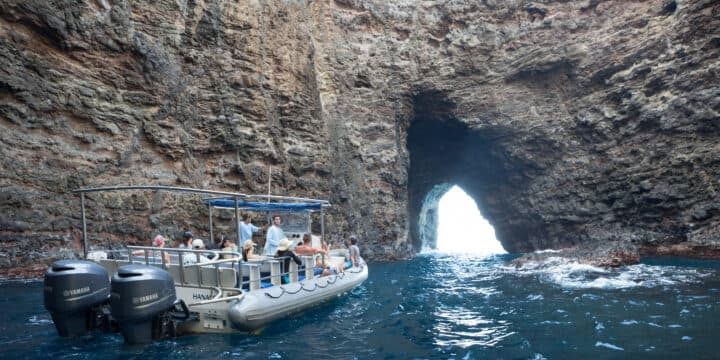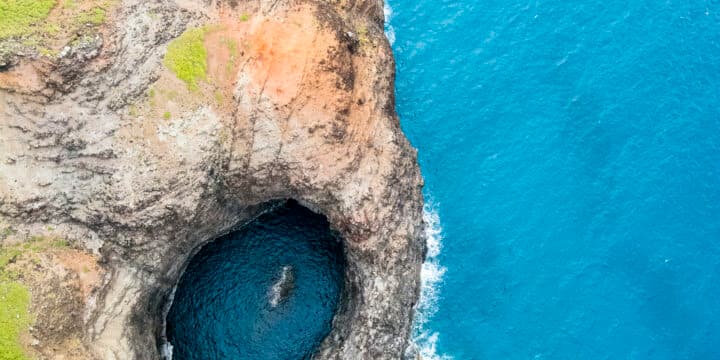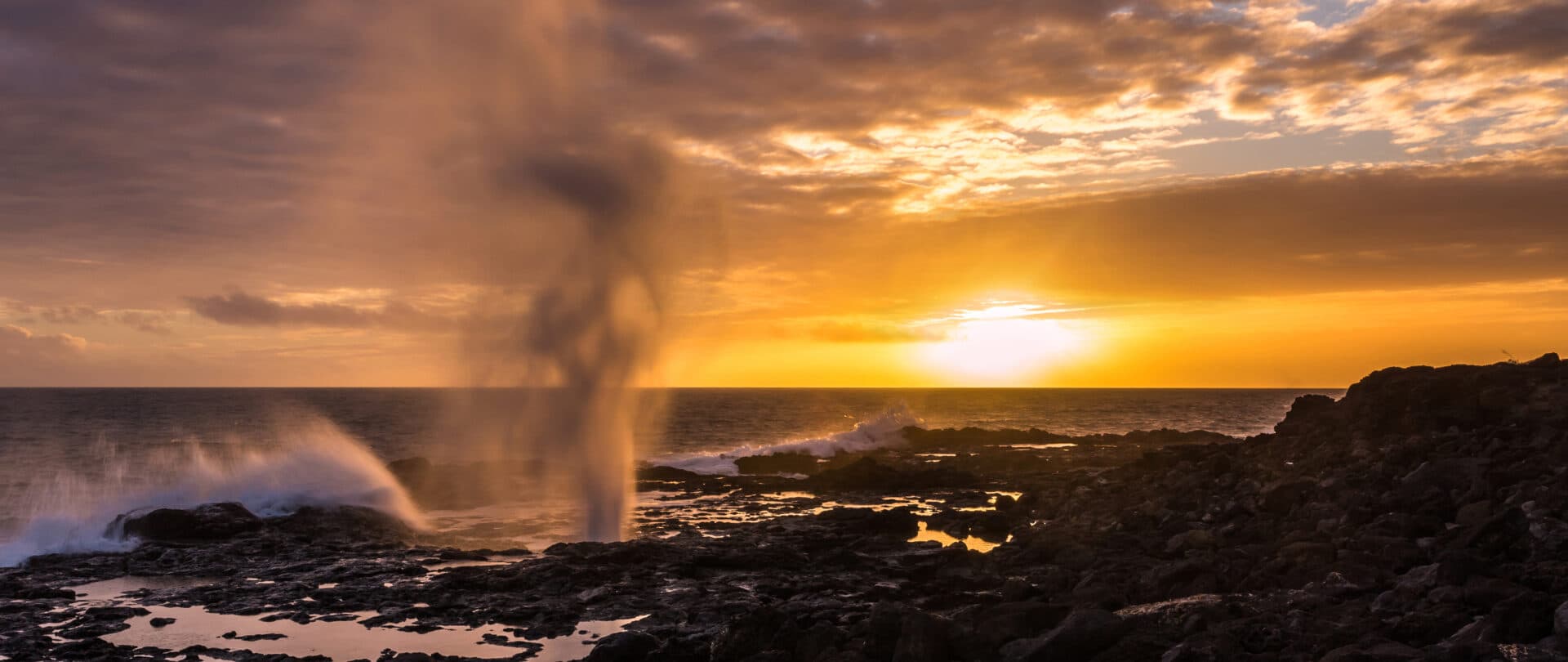
Tubular
Explore the myths and remnants of lava tubes on Kaua‘i.
BY Mary Troy Johnston
Lava tubes on Kaua‘i are not as recognizable and easily accessible as they are on other islands—where it is possible to walk or crawl through a tube. The Thurston Lava Tube, Nāhuku, (the protuberances) better known as Thurston Lava Tube, on the Big Island is a popular attraction where it is possible to walk upright through the tube. On the South Shore of Kaua‘i, Spouting Horn does not resemble the pipeline image one expects of a lava tube. It looks more like a huge geyser of seawater spraying as tall as 50 feet in the air. Yet, a lava tube with two holes in its shelf creates the conditions for this spectacle. The ocean rushes in the tube below the surface and eventually results in enough pressure building to send out a huge burst through one of the holes. The other hole provides the sound effect for the dramatic display, emitting sounds alternatively described as hissing and moaning. It is as if a story is unfolding before one’s eyes, and, interestingly, Hawaiian mythology provides the ancient narrative.
The myth tells the fate of a mo‘o (shapeshifting dragon-like lizard spirit) that stood guard over the shoreline where Spouting Horn is located today. Lizards in Hawaiian legend were not your common garden variety types; they appeared with the ferocity of dragons. For example, Kaikapu, a fearsome mo‘o, was known for eating fishermen. Even ancient gods and goddesses had their hands full grappling with these powerful creatures. Pele, the goddess of the volcano, sent her favorite sister Hi‘iaka to defeat three mo‘o who had taken her lover hostage. Her sister almost fell for a trap, needing to cross a ravine and finding a bridge that suddenly appeared. She did not cross, realizing Kikipua, a magical mo‘o, had slithered his tongue across the ravine making it resemble a plank crossing. One version of the legend linked to Spouting Horn tells of a young boy named Liko who decided to take on Kaikapu, the mo‘o that gobbled up anyone that fished or swam near the area. The young hero laid his own trap, getting the man-eating lizard to swim after him beneath a lava shelf. Liko was able to escape through the hole in the shelf, but the lizard was stuck below and forever imprisoned, hence, the moaning and hissing that continues to this day in tune with the fantastic and wildly spewing water spray of water. The wind rushing through the second hole in the shelf supplies the anguishing sounds of the lizard. Spouting Horn is recognized as one of the most popular and impressive sights on Kaua‘i.
Another collapsed lava tube located along the Nāpali Coast is known as Pukalani in Hawaiian, or the Open Ceiling Cave. Puka means “hole” and lani means “heaven”, thus, a pukalani translates as an “entry or gateway into heaven.” The way to heaven in this cave is through a hole in the top that links the gazer with the sky. This experience is available to kayakers who can fit into the cave, inflatable rafts and other small craft. However, access is physically limited especially because of the existence of a rocky island in the middle which are the remains of the collapsed ceiling. Swimmers have commented on how beautiful the changing color of the water is in the cave lit in different ways throughout the day by the sunlight. Depending on weather conditions, occasionally it is possible for the tour boats to pull up close enough to the coast to point out other lava tubes jutting out from the cliffs. However, only minutes or seconds may permit such viewing.
The National Park Service reports the various uses of lava tubes in the past. Where drinkable water has been in short supply, lava tubes provided a protected source. Water seeped through the porous rock and dripped from cave ceilings. In the past, the water was collected in bowls called ipu, beautifully carved from gourd containers. The coolness of the lava tubes made them good places to store food, or, even for people to seek shelter when the weather was not so friendly outside. They provided burial places and passageways in the past. As for the Open Ceiling Cave, boaters have sought refuge when the ocean is roiling. Some of the uses of the tubes were kept secret, and people sometimes could not speak of their “sacred” purposes because it was kapu (forbidden).
The darkness of lava tunnels makes them hospitable to light avoidant species. The Kaua‘i cave wolf spider (Adelocosa anops) is believed to be almost extinct and exists only on Kaua‘i. Scientists believe the numbers of the species have diminished below 30. Locals refer to it as the “blind spider” because it has no eyes. Rarely sighted, the endangered spider leads a hidden existence in the lava tubes of the Kōloa-Po‘ipū region of the island.
The lava tubes continue to exist as a remnant of an ancient past during which the forces of nature ruled and created Kaua‘i. The sense of awe the remnants produce is still very much extant. When the sea is calm, it is a perfect opportunity to book one of the boat tours of the sea caves of the Nāpali Coast and visit the Open Ceiling Cave. Long mythologized as the home to a shark god, Open Ceiling Cave still holds its sacred allure. The chance to discover these remote and extraordinary enclaves of nature is among the many gifts Kaua‘i has to offer.
Visitors to these public destinations must use an abundance of caution. In the case of Spouting Horn, stay at the lookout within the guardrail. When visiting the Open Ceiling Cave, adhere closely to weather reports (staying mindful that conditions can quickly change), and practice safe boating.
You May Like
Tours on the Nāpali Coast
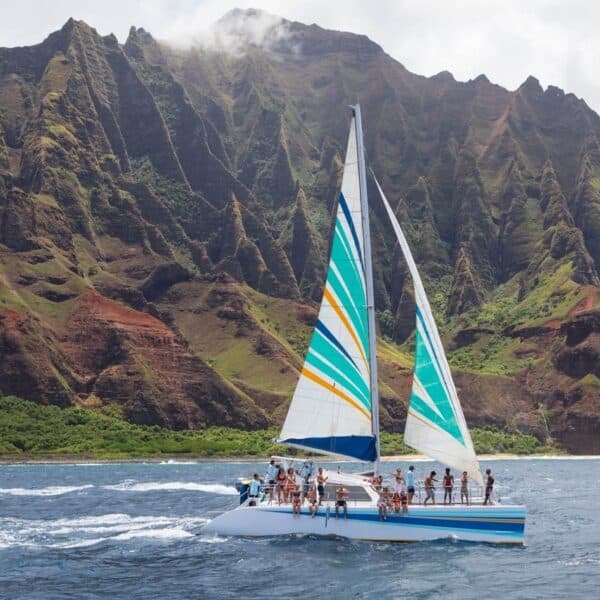
See + Do
Nāpali Coast Snorkel Sail
See the Napali Coast, amazing marine life, and more!
Features
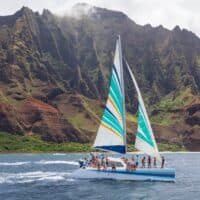
See + Do
